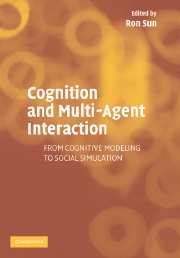Book contents
- Frontmatter
- Contents
- List of Contributors
- Preface
- PART 1 INTRODUCTION
- PART 2 OVERVIEWS OF COGNITIVE ARCHITECTURES
- PART 3 MODELING AND SIMULATING COGNITIVE AND SOCIAL PROCESSES
- PART 4 A SYMPOSIUM
- 15 Cognitive Science and Good Social Science
- 16 Collective Cognition and Emergence in Multi-Agent Systems
- 17 Social Judgment in Multi-Agent Systems
- 18 Including Human Variability in a Cognitive Architecture to Improve Team Simulation
- 19 When Does Social Simulation Need Cognitive Models?
- Index
18 - Including Human Variability in a Cognitive Architecture to Improve Team Simulation
Published online by Cambridge University Press: 15 December 2009
- Frontmatter
- Contents
- List of Contributors
- Preface
- PART 1 INTRODUCTION
- PART 2 OVERVIEWS OF COGNITIVE ARCHITECTURES
- PART 3 MODELING AND SIMULATING COGNITIVE AND SOCIAL PROCESSES
- PART 4 A SYMPOSIUM
- 15 Cognitive Science and Good Social Science
- 16 Collective Cognition and Emergence in Multi-Agent Systems
- 17 Social Judgment in Multi-Agent Systems
- 18 Including Human Variability in a Cognitive Architecture to Improve Team Simulation
- 19 When Does Social Simulation Need Cognitive Models?
- Index
Summary
INTRODUCTION
When sophisticated models of human behavior are used in synthetic environments or video games, they typically attempt to capture normative behavior by providing homogenous agents from a cognitive architecture. A recognized shortcoming of this approach is that in reality people do not always behave in exactly the same manner: no matter how well trained a person might be, there are always instances when they deviate from what is prescribed by their training. Even when following doctrine, there can be considerable variability across individuals (Pew & Mavor, 1998; Ritter et al., 2003). This variability, even after differences in knowledge are removed, arises both from individual differences, where different abilities can lead to marked differences in behavior, and also from behavior moderators – internal and external factors, typically related to time, that moderate individual differences, compounding the effect of individual differences. As well as having a considerable impact on individual behavior, such variability will also strongly influence team and organizational performance.
Much of organizational theory and practice is designed to study individual differences and their impact on team performance, however most existing cognitive architectures create homogenous models unaffected by time. Some social simulation models do explore the impact of individual differences (e.g., cooperative versus non-cooperative agents in Axelrod, 1997; and papers in NAACSOS Conferences), but in such cases, the differences are usually modeled at a coarse level, or simply as differences in knowledge alone. As discussed below, more subtle individual differences can have considerable impact on teams and larger organizational units. COJACK, the architecture introduced in this chapter, is designed to model individual differences and variability in a psychologically plausible manner, facilitating simulation of such phenomena.
- Type
- Chapter
- Information
- Cognition and Multi-Agent InteractionFrom Cognitive Modeling to Social Simulation, pp. 417 - 427Publisher: Cambridge University PressPrint publication year: 2005



